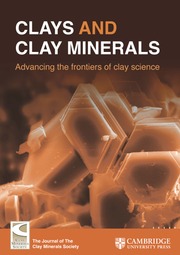Article contents
Optimizing the mechanical strength of adobe bricks
Published online by Cambridge University Press: 01 January 2024
Abstract
Ecologic building materials such as adobe bricks have become of greater economic importance in recent years. In the present work, the addition of selected materials to improve the compressive and bending strengths of adobe bricks was tested. The raw material (loam UD) was analyzed for its mineralogical and chemical composition. The loam studied consisted of quartz, feldspar, and the clay minerals chlorite, vermiculite, illite, and kaolinite. Prerequisites for using this loam for brick making were its grain-size distribution and the absence of expandable clay minerals.
To optimize the compressive and bending strengths of the adobe bricks, seven natural and ‘eco-friendly’ synthetic additives were admixed with the raw material and homogenized.
From this material, small adobe bricks and bars were made. One series of bricks and bars was made without additives but instead was coated with a hydrophobic impregnation cream. The bricks were stored for up to 20 days at 100 and 75% relative humidity (RH). After 1, 5, and 20 days, the compressive and bending strengths were measured to identify the critical humidity level for brick strength. The compressive and bending strengths of loam UD at dryconditions without additives showed values of 9 N/mm2 and 4.8 N/mm2, respectively. With some of the additives, the strength improved by up to 30%. The greatest increases in strength were achieved by mixing the loam with Acronal S650. Finely ground trass and diatomite also increased the dry strength. After storage at high levels of RH, these mixtures lost >50% strength. In contrast, the loam mixed with blast-furnace slag has a small initial strength but showed the smallest decreases in strength after exposure to high levels of RH.
Keywords
Information
- Type
- Article
- Information
- Copyright
- © The Clay Minerals Society 2009
References
- 7
- Cited by

